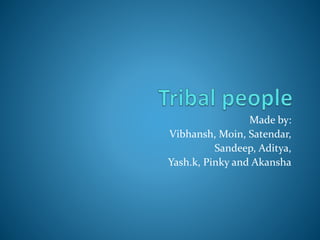
Tribal group
- 1. Made by: Vibhansh, Moin, Satendar, Sandeep, Aditya, Yash.k, Pinky and Akansha
- 2. Tribal people • In this presentation we are going to cover the following points: 1. Introduction about Changpa. 2. Changpa of the Tibet Autonomous Region. 3. Changpa of Jammu and Kashmir. 4. Extra information about Changpa.
- 3. Introduction The Changpa are a semi-nomadic Tibetan ethnic group found mainly in Zanskar region of Jammu and Kashmir. A smaller number were also in the western regions of the tibet Autonomous Region until they suffered forced relocation by the Chinese government. Changpas are the nomadic tribes of Changthang plateau in Ladakh range of Jammu and Kashmir. Their main source of income comes from animal husbandry. Changpas also engage in petty trade. Barley is cultivated by these tribes. They collect salt from the northern shore of the Tsokar Lake in Rupshu and sell it in Ladakh. They live in tents made from the hair of yaks and goats. These tribes believe in local deities and some of them have converted into Buddhism.
- 4. Changpa of the Tibet Autonomous Region. • The homeland of the Changpa is a highaltitude plateau known as the Changtang, which forms a portion of western and northern Tibet extending into southeastern Ladakh, and Changpa means "northerners" in Tibetan. Unlike many other nomadic groups in Tibet, the Changpa are not under pressure from settled farmers as the vast majority of land they inhabit is too inhospitable for farming. • Most of the Tibetan Changtang is now protected nature reserves consisting of the Changtang Nature Reserve, the second-largest nature reserve in the world, and four new adjoining smaller reserves totalling 496,000 km2. (191,507 sq. miles) of connected Nature Reserves, which represents an area almost as large as Spain, and bigger than 197 countries.
- 5. Changpa of the Tibet Autonomous Region. • Since the reserves have been established there has been a welcome increase in the numbers of endangered species. The protected areas stretch across parts of the Tibet Autonomous Region, Xinjiang and Qinghai in China.
- 6. Changpa of Jammu and Kashmir. • The Changpa of Ladakh are high altitude pastoralists, raising mainly yaks and goats. Among the Lasakh Changpa, those who are still nomadic are known as Phalpa, and they take their herds from in the Hanley Valley to the village of Lato. Hanley is home to six isolated settlements, where the sedentary Changpa, the Fangpareside. Despite their different lifestyles, both these groups intermarry. The Changpa speak Changskhat, a dialect of Tibetan, and practice Tibetan Buddhism. • As of 2001, the Changpa were classified as a Scheduled Tribe under the Indian government's reservation program of affirmative action.
- 7. Changpa of Jammu and Kashmir. • Only a small part of Changthang crosses the border into Ladakh, in the Indian state of Jammu and Kashmir. It is, however, on a historically important route for travelers journeying from Ladakh to Lhasa, and now has many different characteristics due to being part of India. Historically, the Changpa of the Lasakh would migrate with their herds into Tibet, but with Chinese occupation of Tibet, this route has been closed.
- 8. Extra information about Changpa. • No culture of any of the tribal communities of India is regarded to be ennobled without treasure of its culture and traditional exuberances. In this regard, the status of the Changpa tribes is quite high. It has been rightly been seen in several of its aspects like housing, dance, music, festivals, etc. • This tribal community form Jammu and Kashmir prefers to reside in beautiful tents that are nicely prepared form the hairs of yaks and goats. Like many of the tribal communities, this Changpa tribal community too is widely oriented towards religion and several of the spiritual beliefs and customs.
- 9. Extra information about Changpa. • However, these Changpa tribes still retained their heritage of observing local religious rites and customs. Also in the Changpa tribal society, there is no death of local deities and goddesses. According to some of the anthropologists, there are few Muslims also who celebrate festival of Ramzan and Eid in lots of reverence. Apart from Jammu and Kashmir valley, many of this Changpa tribal community also are found in other places of India.
- 10. Thank You Thank You For Viewing This Slideshow. Thank You For Giving Your Precious Time. At Last Thank You Very Much.